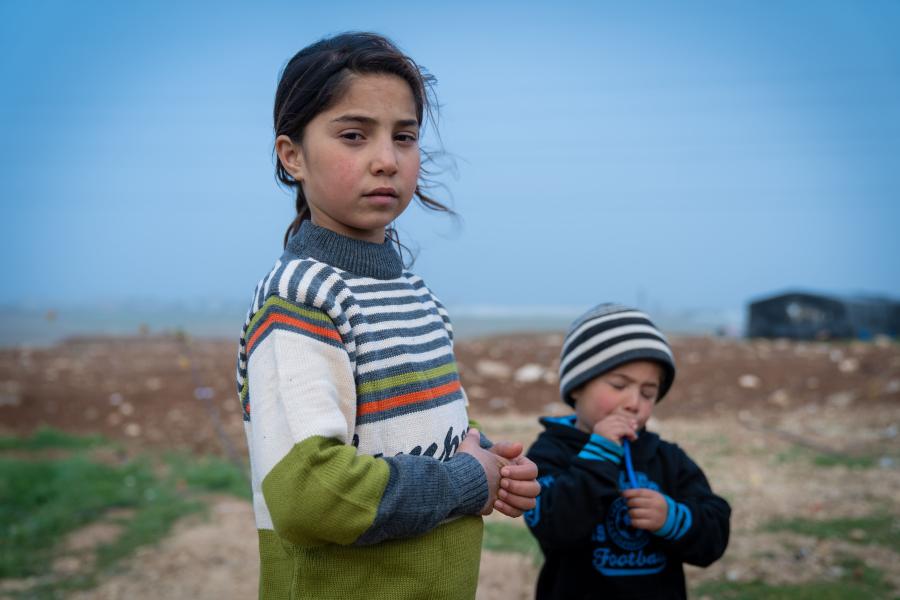Children in Jordan at risk of the impacts of the climate crisis
21 August 2021
For the first time, UNICEF ranks countries based on children’s exposure and vulnerability to climate and environmental shocks, with Jordanian children the world’s 94 most vulnerable.

Young people living in Jordan are among those at risk of the impacts of climate change, threatening their health, education, and protection, according to a UNICEF report launched today.
‘The Climate Crisis Is a Child Rights Crisis: Introducing the Children’s Climate Risk Index’ is the first comprehensive analysis of climate risk from a child’s perspective. It ranks countries based on children’s exposure to climate and environmental shocks, such as cyclones and heatwaves, as well as their vulnerability to those shocks, based on their access to essential services.
Launched in collaboration with Fridays for Future on the third anniversary of the youth-led global climate strike movement, the report finds approximately 1 billion children – nearly half the world's 2.2 billion children – live in one of the 33 countries classified as “extremely high-risk”. The findings reflect the number of children impacted today; figures likely to get worse as the impacts of climate change accelerate.
While Sudan and Yemen are among these “extremely high-risk” countries, with a ranking of 15 and 23 consecutively, Jordan ranks at 94, preceded by Japan and followed by Kyrgyzstan. The report found Jordanian children are exposed to water scarcity risk followed by air, soil and water pollution.
“The climate crisis is a child’s rights crisis,” said Tanya Chapuisat, Representative, UNICEF Jordan, “Every child in Jordan is now exposed to at least one climate or environmental shock. These hazards will increase in severity as the impacts of climate change accelerate.”
Globally, an estimated 850 million children – 1 in 3 worldwide – live in areas where at least four of climate and environmental shocks overlap. As many as 330 million children – 1 in 7 worldwide – live in areas affected by at least five major shocks.
The report also reveals a disconnect between where greenhouse gas emissions are generated, and where children are enduring the most significant climate-driven impacts. The 33 extremely high-risk countries collectively emit just 9 per cent of global CO2 emissions. Conversely, the 10 highest emitting countries collectively account for nearly 70 per cent of global emissions. Only one of these countries is ranked as ‘extremely high-risk’ in the index.
Without the urgent action required to reduce greenhouse gas emissions, children will continue to suffer the most. Compared to adults, children require more food and water per unit of their body weight, are less able to survive extreme weather events, and are more susceptible to toxic chemicals, temperature changes and diseases, among other factors.
UNICEF is supporting the Government of Jordan in its national climate change policy that includes children’s perspectives. UNICEF also integrates greening and climate-friendly initiatives across its programmes.
At the community level, UNICEF strengthens their resilience to climate change, especially that of most vulnerable people. This is carried out by raising their awareness to the risks of climate change, and empowering them, especially young people to influence national policies. These actions can make a significant difference in our ability to safeguard the futures of children from the impacts of climate change.
“Climate change action cannot wait. We need to work collectively to prioritise and strengthen climate actions in line with the Convention on the Rights of the Child, which Jordan has ratified in 1991,” said Chapuisat. “The Convention presents us with a greater opportunity to better address the unfair climate change related challenges most vulnerable children in the country are facing.”
UNICEF is calling on governments, businesses, and relevant actors to:
- Increase investment in climate adaptation and resilience in key services for children. To protect children, communities and the most vulnerable from the worst impacts of the already changing climate, critical services must be adapted, including water, sanitation, and hygiene systems, health, and education services.
- Reduce greenhouse gas emissions. To avert the worst impacts of the climate crisis, comprehensive and urgent action is required. Countries must cut their emissions by at least 45% (compared to 2010 levels) by 2030 to keep warming to no more than 1.5 degrees Celsius.
- Provide children with climate education and greens skills, critical for their adaptation to and preparation for the effects of climate change. Children and young people will face the full devastating consequences of the climate crisis and water insecurity, yet they are the least responsible. We have a duty to all young people and future generations.
- Include young people in all national, regional, and international climate negotiations and decisions, including at COP26. Children and young people must be included in all climate-related decision making.
- Ensure the recovery from the COVID-19 pandemic is green, low-carbon and inclusive, so that the capacity of future generations to address and respond to the climate crisis is not compromised.
Notes to Editors:
The CCRI was developed in collaboration with several partners including the Data for Children Collaborative.
The Children’s Climate Risk Index (CCRI) reveals:
- 240 million children are highly exposed to coastal flooding.
- 330 million children are highly exposed to riverine flooding.
- 400 million children are highly exposed to cyclones.
- 600 million children are highly exposed to vector borne diseases.
- 815 million children are highly exposed to lead pollution.
- 820 million children are highly exposed to heatwaves.
- 920 million children are highly exposed to water scarcity.
- 1 billion children are highly exposed to exceedingly high levels of air pollution[2]
In order to make the report more accessible to global youth, UNICEF also collaborated with Climate Cardinals, an international youth led non-profit which translates climate change research and information so that they can reach as many young people and leaders as possible.



